Last updated: July 22, 2024
Lesson Plan
Less Pollution: The Best Solution

Protect the environment and nature.
National Park Service
- Grade Level:
- Lower Elementary: Pre-Kindergarten through Second Grade
- Subject:
- Science
- Lesson Duration:
- 60 Minutes
- State Standards:
- Kentucy
Science
K-ESS2-2. Construct an argument supported by evidence for how plants and animals (including humans) can change the environment to meet their needs.
Essential Question
What can we do to reduce pollution to help our environment?
Objective
The objective of this lesson is to communicate with students what pollution is, how humans contribute to pollution and what we can do to reduce pollution to help our environment.
Background
The background information needed for this lesson is what pollution is. Pollution is anything that makes the Earth dirty and unhealthy, affecting the land, air, and water. Pollution can be a wide variety of things including throwing out trash, driving a vehicle, dumping things into our oceans and rivers, and even spraying chemicals is a part of pollution.
Preparation
- Gather supplies
- Clean Trash
- This will be used during the activity. This can be a variety of different items. You can have students bring items from home, use items from school, or the teacher can provide the items.
- Examples and pictures of pollution
- Clean Trash
Lesson Hook/Preview
A fun activity that could get kids thinking about what pollution is and how it can directly affect one individual person is having students line up and each of them have a piece of “trash”(this can include any items like napkins, plates, cups, water bottles, etc.). Students will be asked to line up and one at a time they will be asked to pass their piece of “trash” to the person behind them, until eventually the last person in the line has everyone’s trash. This is an actual representation of what happens when one person throws out or dumps one piece of trash. This lesson is important because it can demonstrate in real time what happens when they do something as small as throwing out an old water bottle or dumping a Ziploc bag into a creek and help them come up with ways to stop and help teach their families not to pollute the Earth as well.
Procedure
Step one: The first step of this lesson will be to ensure that students understand what pollution means and the impact that it has on our Earth.
Step two: Provide examples and pictures of pollution in different aspects of the Earth(water, air, land).
Step three: Discuss steps that we can take to reduce the amount of pollution that we contribute to the environment (reduce, reuse, and recycle).
Step four: The students can then line back up with their piece of “trash” and as they pass begin to pass it down the line they can see if it is something that can be recycled(paper, plastic, or cans). They can then see if any items can be reused(water bottles, etc), and see how much of an impact that they can make on the environment just by doing those small two things.
Vocabulary
Pollution: anything that makes the Earth dirty and unhealthy, affecting the land, air, and water
Impact: effect something or someone has on something else
Solution: answer to a problem
Assessment Materials
ObserveYou will be able to see that the students understood the objective if they can accurately give you ways that we can reduce the impact of humans on Earth, if they can identify ways that we can recycle, and if they can identify what pollution is.
Rubric/Answer Key
Meets Kentucky K - 2nd grade science standards. This lesson was created by Kentucky teachers as a part of the History and Science Explore Project.
Contact Information
Email us about this lesson plan
